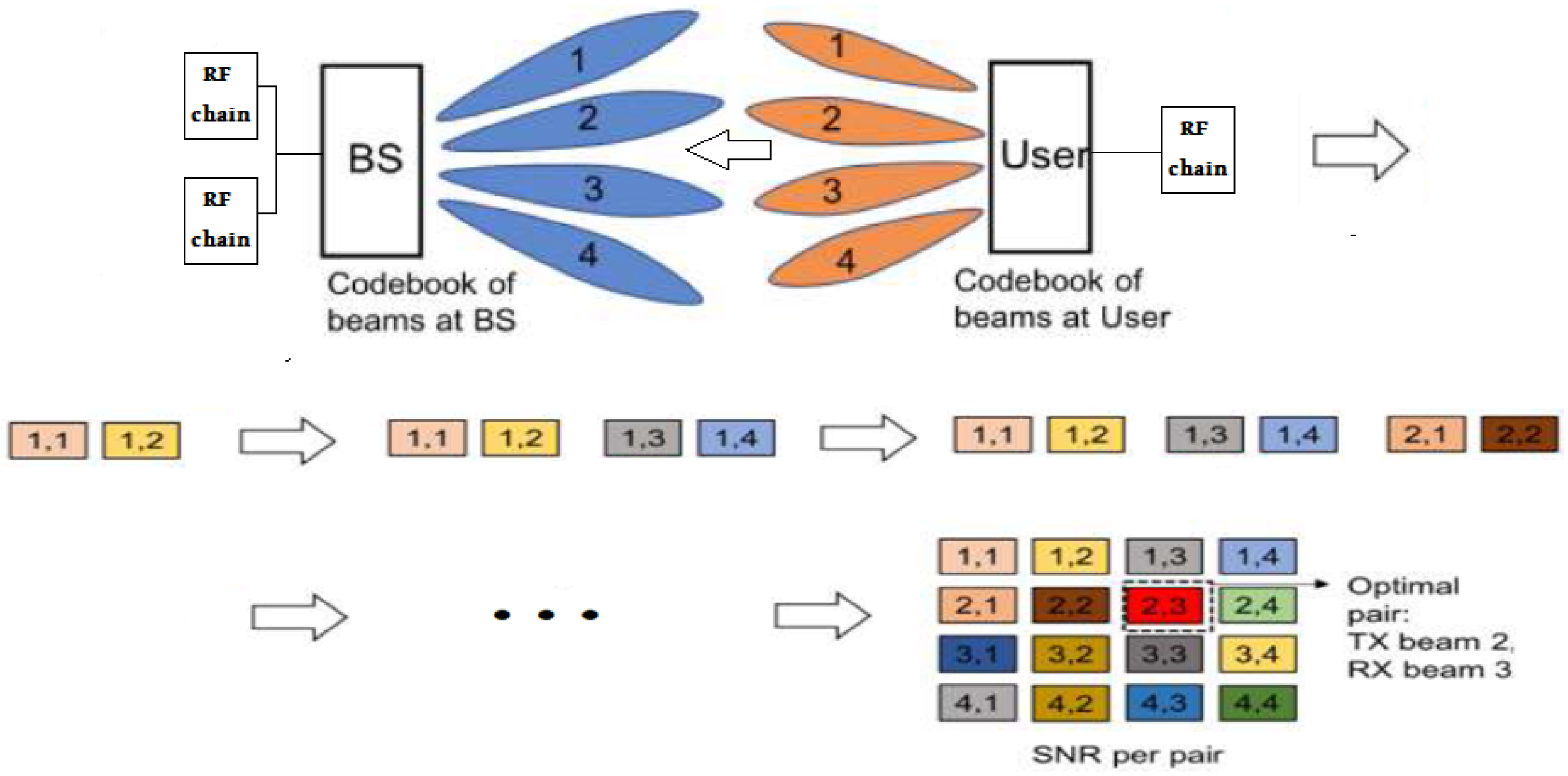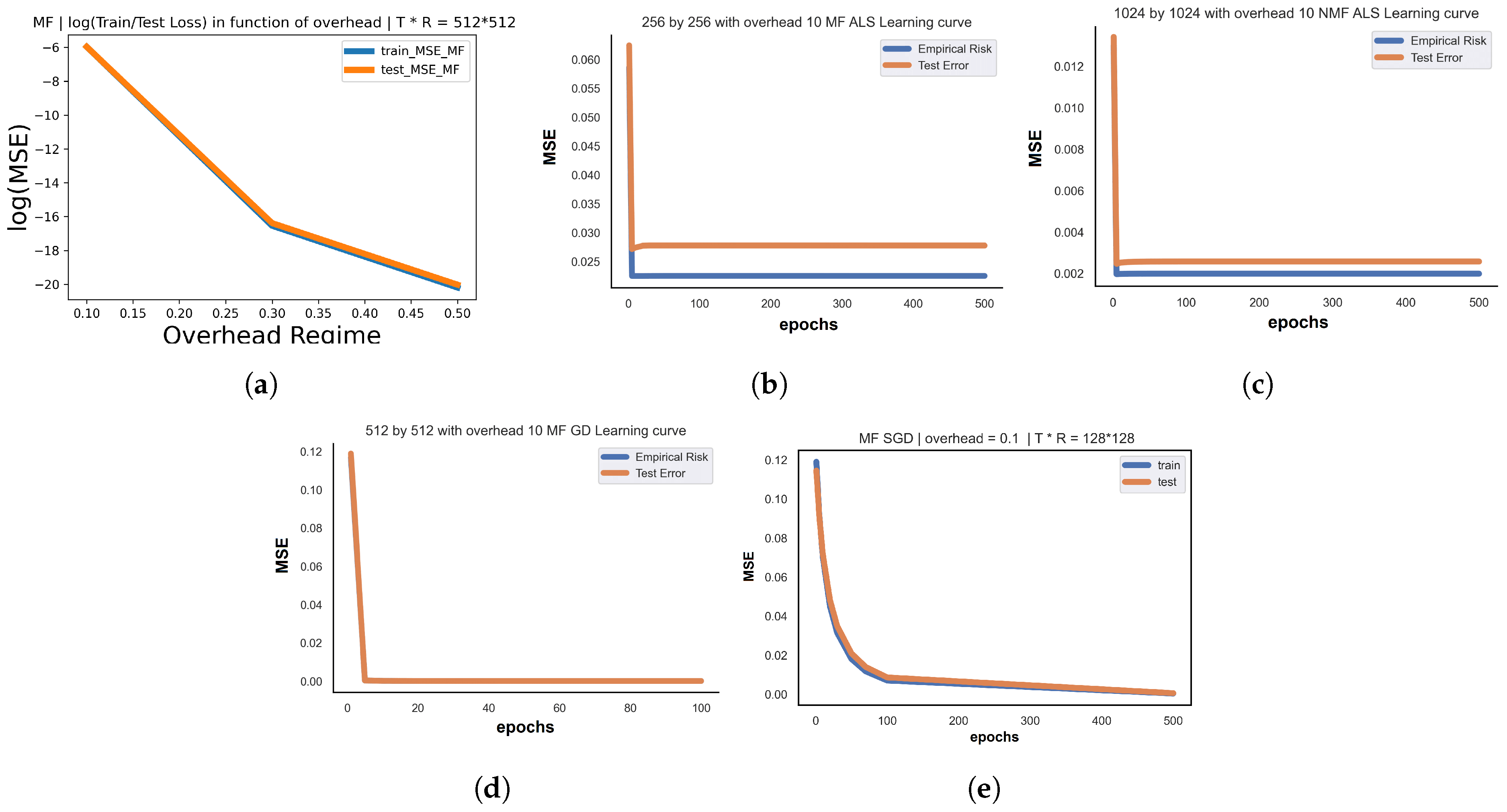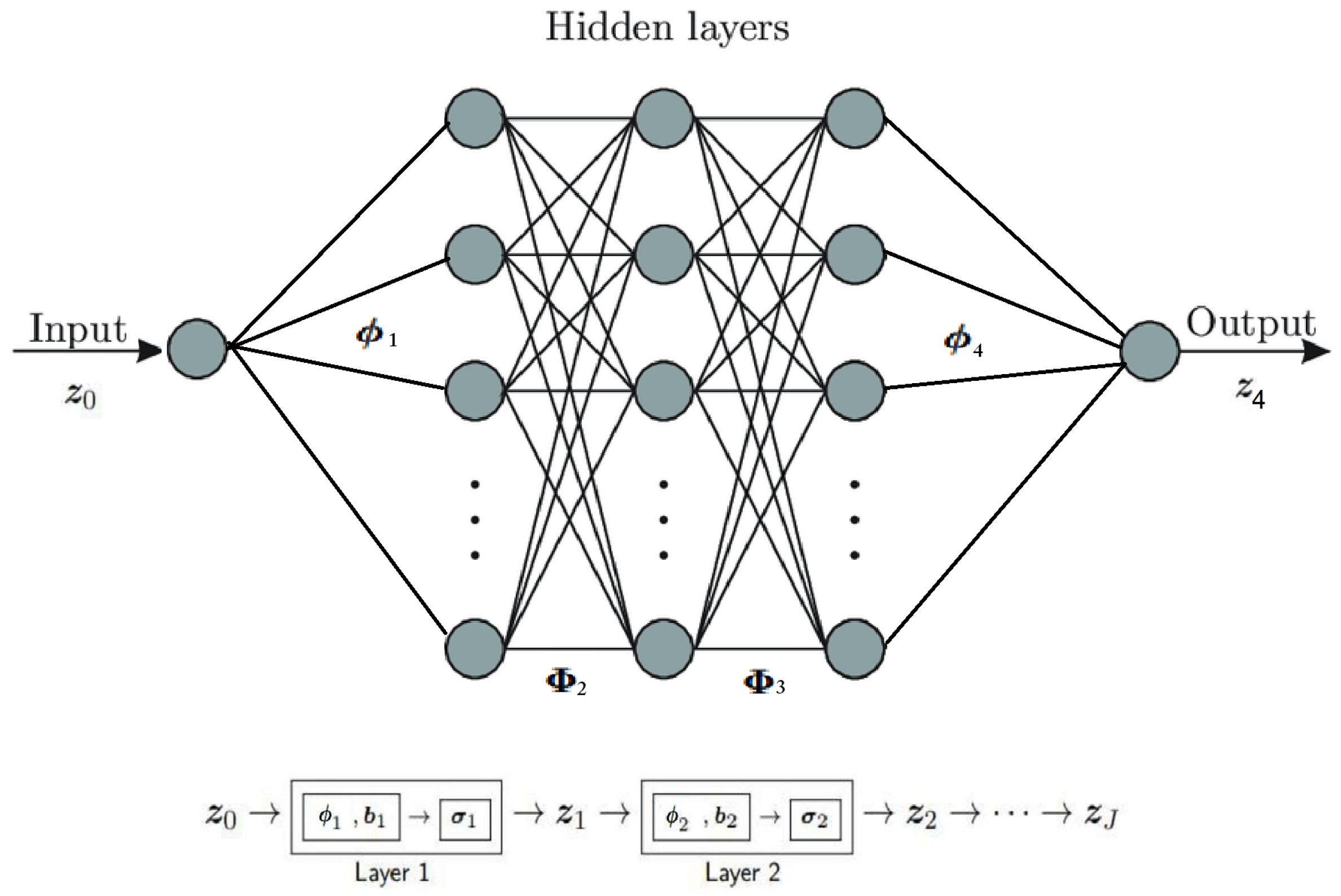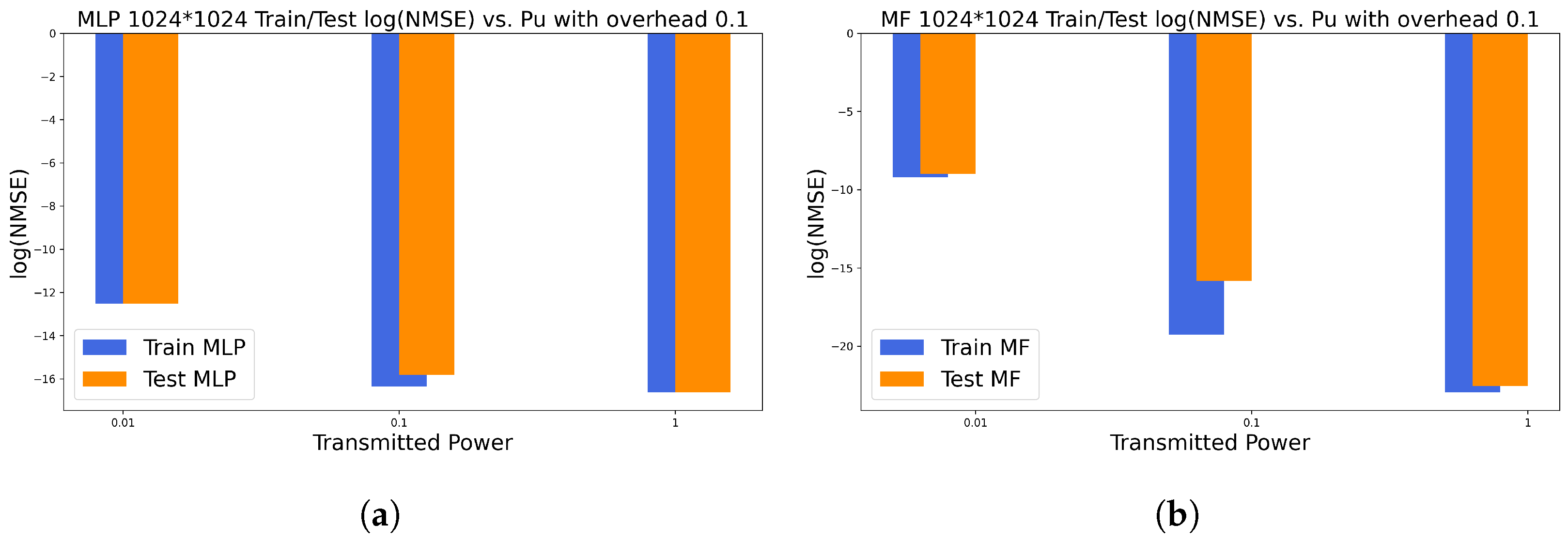Machine Learning Techniques for Blind Beam Alignment in mmWave Massive MIMO
Abstract
:1. Introduction
- We formulate the MF and NMF problems. We propose to use Block Coordinate Descent (BCD) and Block Gradient Descent (BGD) methods to solve each problem. We derive in depth all the update equations for these methods. We show that the BCD method converges to a stationary point from both MF and NMF problems. Our extensive numerical results show that, sub-sampling of the BS/UE codebooks, the remaining RSE values can be predicted extremely well (with a training/test error ) for every antenna configuration.
- We develop at length the equations of a general MLP model, the resulting loss function, and the corresponding optimization problem. In addition, we derive the equations of back-propagation for the MLP in question. Using extensive numerical results, we observe that sounding of original codebooks is sufficient to predict the RSE of the beam pairs that were not sounded, with negligible training/test error.
- We numerically compare the training/test losses of all the proposed models for a varying cardinality of codebooks and transmit powers. These results suggest that the BCD method for MF/NMF outperforms the MLP in terms of training and test error. Meanwhile, BCD for MF/NMF has a large computational complexity and the MLP exhibits medium complexity.
- Interestingly, by sounding of the BS/UE codebooks, the proposed ML models can predict the unknown RSE (beam pairs not sounded) with a negligible test error. Thus, the proposed methods achieve a reduction in pilot signaling overhead, compared with the SotA benchmark, without any noticeable loss in performance.
- Problem Statement: The main challenge addressed in this study is the high signaling overhead in Beam Alignment for mmWave MIMO systems, which hampers the efficient selection of optimal beam-steering directions.
- Research Questions and Hypotheses: This study investigates whether machine learning methods can effectively reduce the signaling overhead required for accurate beam-pair prediction in mmWave MIMO systems.
- Objectives and Aims: The primary objective is to develop and evaluate ML-based BA methods that minimize the training overhead while maintaining high accuracy in predicting the RSE for unsounded beam pairs.
- Significance and Rationale: The study proposes a novel approach to BA using ML techniques, which can lead to a substantial reduction in pilot signaling overhead and enhance the efficiency of future wireless communication systems.
2. Literature Survey
3. System Model
4. Matrix Factorization and Non-Negative Matrix Factorization
4.1. MF and NMF Problem Formulation
4.2. Solutions for MF
4.3. Solutions for NMF
4.4. Prediction for MF and NMF
4.5. Proposed BA Algorithm Using MF/NMF
| Algorithm 1 Proposed MF/NMF-Based BA Method. |
|
4.6. Numerical Simulations
5. Multi-Layer Perceptron
5.1. MLP Problem Formulation
5.2. MLP Learning
5.3. Prediction Using MLP
5.4. Proposed BA Algorithm Using
| Algorithm 2 Proposed MLP-Based BA Method. |
|
5.5. Numerical Simulations
6. Results and Discussion
6.1. Train/Test Prediction Performance Comparison
6.2. Similarities and Differences between Models
7. Conclusions
Author Contributions
Funding
Institutional Review Board Statement
Data Availability Statement
Conflicts of Interest
Abbreviations
| ALS | Alternating Least Squares |
| AoD | Angle of Departure |
| AoA | Angle of Arrival |
| AWGN | Additive White Gaussian Noise |
| BA | Beam Alignment |
| BS | Base Station |
| BCE | Binary Cross Entropy |
| BCD | Block Coordinate Descent |
| BGD | Block Gradient Descent |
| BSGD | Block Stochastic Gradient Descent |
| CSI | Channel State Information |
| DFT | Discrete Fourier Transform |
| GD | Gradient Descent |
| LoS | Line of Sight |
| MF | Matrix Factorization |
| MIMO | Multiple Input Multiple Output |
| ML | Machine Learning |
| MLP | Multi-Layer Perceptron |
| MSE | Mean Squared Error |
| NMF | Non-Negative Matrix Factorization |
| NLoS | Non Line of Sight |
| NMSE | Normalized Mean Squared Error |
| OFDM | Orthogonal Frequency Division Multiplexing |
| QoS | Quality of Service |
| ReLu | Rectified Linear Unit |
| RSE | Received Signal Energies |
| SNR | Signal-to-Noise Ratio |
| UE | User Equipment |
Appendix A. Proof: BCD Convergence
- (i)
- The loss function is strongly convex, per block; i.e., we need to show that sub-problem S1 and S2 have a unique solution.
- (ii)
- The constraints of the MF prob , are separable and individually convex.
References
- Wang, Y.; Wei, Z.; Feng, Z. Beam Training and Tracking in MmWave Communication: A Survey. arXiv 2022, arXiv:2205.10169. [Google Scholar]
- IEEE Std 802.15.3c-2009; IEEE Standard for Information Technology—Local and Metropolitan Area Networks—Specific requirements—Part 15.3: Amendment 2: Millimeter-Wave-Based Alternative Physical Layer Extension. IEEE: Piscataway, NJ, USA, 2009.
- IEEE Std 802.11ad-2012; IEEE Standard for Information technology—Telecommunications and Information Exchange between Systems—Local and Metropolitan Area Networks—Specific Requirements-Part 11: Wireless LAN Medium Access Control (MAC) and Physical Layer (PHY) Specifications Amendment 3: Enhancements for Very High Throughput in the 60 GHz Band. IEEE: Piscataway, NJ, USA, 2012.
- 3GPP. TS 38.211 V16.7.1 NR; Physical Channels and Modulation; ETSI Technical Specification 138 211 V16.10.0; Released: 07/2022. Available online: https://www.etsi.org/deliver/etsi_ts/138200_138299/138211/16.10.00_60/ts_138211v161000p.pdf (accessed on 9 July 2024).
- Noh, S.; Zoltowski, M.D.; Love, D.J. Multi-Resolution Codebook and Adaptive Beamforming Sequence Design for Millimeter Wave Beam Alignment. IEEE Trans. Wirel. Commun. 2017, 16, 5689–5701. [Google Scholar] [CrossRef]
- Kokshoorn, M.; Chen, H.; Wang, P.; Li, Y.; Vucetic, B. Millimeter Wave MIMO Channel Estimation Using Overlapped Beam Patterns and Rate Adaptation. IEEE Trans. Signal Process. 2016, 65, 601–616. [Google Scholar] [CrossRef]
- Tsang, Y.M.; Poon, A.S.Y.; Addepalli, S. Coding the Beams: Improving Beamforming Training in mmWave Communication System. In Proceedings of the 2011 IEEE Global Telecommunications Conference—GLOBECOM 2011, Houston, TX, USA, 5–9 December 2011; pp. 1–6. [Google Scholar] [CrossRef]
- Buzzi, S.; D’Andrea, C. Subspace Tracking and Least Squares Approaches to Channel Estimation in Millimeter Wave Multiuser MIMO. IEEE Trans. Commun. 2019, 67, 6766–6780. [Google Scholar] [CrossRef]
- Khordad, E.; Collings, I.B.; Hanly, S.V.; Caire, G. Compressive Sensing Based Beam Alignment Schemes for Time-Varying Millimeter-Wave Channels. IEEE Trans. Wirel. Commun. 2023, 22, 1604–1617. [Google Scholar] [CrossRef]
- Ghauch, H.; Skoglund, M.; Shokri-Ghadikolaei, H.; Fischione, C.; Sayed, A.H. Learning Kolmogorov Models for Binary Random Variables. In Proceedings of the International Conference on Machine Learning Workshop, Stockholm, Sweden, 10–15 July 2018. [Google Scholar]
- Yetis, C.M.; Björnson, E.; Giselsson, P. Joint Analog Beam Selection and Digital Beamforming in Millimeter Wave Cell-Free Massive MIMO Systems. arXiv 2021, arXiv:2103.11199. [Google Scholar] [CrossRef]
- Dreifuerst, R.M.; Heath, R.W.; Yazdan, A. Massive MIMO Beam Management in Sub-6 GHz 5G NR. arXiv 2022, arXiv:2204.06064. [Google Scholar]
- Ma, K.; He, D.; Sun, H.; Wang, Z.; Chen, S. Deep Learning Assisted Calibrated Beam Training for Millimeter-Wave Communication Systems. arXiv 2021, arXiv:2101.05206. [Google Scholar] [CrossRef]
- Nguyen, K.N.; Ali, A.; Mo, J.; Ng, B.L.; Va, V.; Zhang, J.C. Beam Management with Orientation and RSRP using Deep Learning for Beyond 5G Systems. arXiv 2022, arXiv:2202.02247. [Google Scholar]
- Aldalbahi, A.; Shahabi, F.; Jasim, M. BRNN-LSTM for Initial Access in Millimeter Wave Communications. Electronics 2021, 10, 1505. [Google Scholar] [CrossRef]
- Dehkordi, S.K.; Kobayashi, M.; Caire, G. Adaptive Beam Tracking based on Recurrent Neural Networks for mmWave Channels. arXiv 2021. [Google Scholar] [CrossRef]
- Hussain, M.; Michelusi, N. Learning and Adaptation for Millimeter-Wave Beam Tracking and Training: A Dual Timescale Variational Framework. arXiv 2021. [Google Scholar] [CrossRef]
- Dreifuerst, R.M.; Daulton, S.; Qian, Y.; Varkey, P.; Balandat, M.; Kasturia, S.; Tomar, A.; Yazdan, A.; Ponnampalam, V.; Heath, R.W. Optimizing Coverage and Capacity in Cellular Networks using Machine Learning. arXiv 2021, arXiv:2010.13710. [Google Scholar]
- Narengerile, N.; Thompson, J.; Patras, P.; Ratnarajah, T. Deep Reinforcement Learning-Based Beam Training for Spatially Consistent Millimeter Wave Channels. In Proceedings of the 2021 IEEE 32nd Annual International Symposium on Personal, Indoor and Mobile Radio Communications (PIMRC), Helsinki, Finland, 13–16 September 2021; pp. 579–584. [Google Scholar] [CrossRef]
- Wang, L.; Ai, B.; Niu, Y.; Gao, M.; Zhong, Z. Adaptive Beam Alignment Based on Deep Reinforcement Learning for High Speed Railways. In Proceedings of the 2022 IEEE 95th Vehicular Technology Conference: (VTC2022-Spring), Helsinki, Finland, 19–22 June 2022; pp. 1–6. [Google Scholar] [CrossRef]
- Ktari, A.; Ghauch, H.; Rekaya, G. Matrix Factorization for Blind Beam Alignment in Massive mmWave MIMO. In Proceedings of the 2022 IEEE Wireless Communications and Networking Conference (WCNC), Austin, TX, USA, 10–13 April 2022; pp. 2637–2642. [Google Scholar] [CrossRef]
- Ktari, A.; Ghauch, H.; Rekaya, G. Cascaded binary classifiers for blind Beam Alignment in mmWave MIMO using one-bit quantization. In Proceedings of the International Conference on Communications (ICC), WS02 ICC23 Workshop, DDINS, Rome, Italy, 28 May–1 June 2023. [Google Scholar]










| System Configuration for All Proposed Models | |
|---|---|
| System parameter | Numerical value |
| number of antennas at | |
| number of antennas at | |
| codebook cardinality at | |
| codebook cardinality at | |
| overhead ratio regime | |
| number of sub-carriers | 64 |
| number of channel paths L | 2 (NLoS) |
| transmitted power (W) | |
| dimension | |
| learning rate | |
| regularization factors | |
| number of layers J | |
| number of neurons per layer | |
| batch size B | |
| learning rate | |
| a | | Minimum Overhead Required for W | ||||
|---|---|---|---|---|
| MIMO setup | Optimal hyperparameters | Min Overhead | Train NMSE | Test NMSE |
| 128 by 128 | BGD NMF{D = 2, (, ) = (0.0001, 0.0001), = 0.001} | 0.1 | 8.407746 | 9.147875 |
| 256 by 256 | BGD MF{D = 3, (, ) = (0.0001, 0.0001), = 0.001} | 0.1 | 4.102708 | 7.344720 |
| 512 by 512 | BGD MF{D = 4, (, ) = (0.0001, 0.0001), = 0.001} | 0.1 | 8.374633 | 9.417057 |
| 1024 by 1024 | SGD NMF{D = 4, (, ) = (0.0001, 0.0001), = 0.01} | 0.1 | 1.219227 | 1.616363 |
| b | | Minimum Overhead Required for W | ||||
| MIMO setup | Optimal hyperparameters | Min Overhead | Train NMSE | Test NMSE |
| 128 by 128 | SGD NMF {D = 2, (, ) = (0.0001, 0.0001), = 0.001} | 0.1 | 0.000191 | 0.000276 |
| 256 by 256 | SGD NMF {D = 3, (, ) = (0.0001, 0.0001), = 0.001} | 0.1 | 4.648861 | 5.775554 |
| 512 by 512 | BGD NMF{D = 4, (, ) = (0.0001, 0.0001), = 0.001} | 0.1 | 1.052556 | 1.170430 |
| 1024 by 1024 | BGD NMF {D = 4, (, ) = (0.0001, 0.0001), = 0.001} | 0.1 | 1.600790 | 1.695907 |
| c | | Minimum Overhead Required for W | ||||
| MIMO setup | Optimal hyperparameters | Min overhead | Train NMSE | Test NMSE |
| 128 by 128 | SGD MF {D = 2, (, ) = (0.0001, 0.0001), = 1 } | 0.1 | 0.115517 | 0.118776 |
| 256 by 256 | BGD MF {D = 3, (, ) = (0.0001, 0.0001), = 0.0001} | 0.1 | 0.016475 | 0.016679 |
| 512 by 512 | SGD NMF{D = 4, (, ) = (0.0001, 0.0001), = 1 } | 0.1 | 0.003371 | 0.003449 |
| 1024 by 1024 | BGD MF {D = 4, (, ) = (0.0001, 0.0001), = 1 } | 0.1 | 0.001681 | 0.001948 |
| a | | Minimum Overhead Required for W | ||||
|---|---|---|---|---|
| MIMO setup | Optimal hyperparameters | Min overhead | Train NMSE | Test NMSE |
| 128 by 128 | {(J = 3, D = 8), B = 4, = 0.0001} | 0.1 | 0.001144 | 0.002639 |
| 256 by 256 | {(J = 3, D = 16), B = 16, = 0.001} | 0.1 | 3.941522 | 3.948157 |
| 512 by 512 | {(J = 3, D = 64), B = 32, = 0.0001} | 0.1 | 3.305507 | 3.335168 |
| 1024 by 1024 | {(J = 3, D = 64), B = 64, = 0.0001} | 0.1 | 9.810028 | 9.857067 |
| b | | Minimum Overhead Required for W | ||||
| MIMO setup | Optimal hyperparameters | Min overhead | Train NMSE | Test NMSE |
| 128 by 128 | {(J = 3, D = 8), B = 4, = 0.0001} | 0.1 | 0.007569 | 0.007662 |
| 256 by 256 | {(J = 3, D = 16), B = 16, = 0.001} | 0.1 | 0.000139 | 0.000288 |
| 512 by 512 | {(J = 3, D = 64), B = 32, = 0.0001} | 0.1 | 5.419598 | 5.756302 |
| 1024 by 1024 | {(J = 3, D = 64), B = 64, = 0.0001} | 0.1 | 1.184073 | 1.72301 |
| c | | Minimum Overhead Required for W | ||||
| MIMO setup | Optimal hyperparameters | Min overhead | Train NMSE | Test NMSE |
| 128 by 128 | {(J = 3, D = 8), B = 4, = 0.0001} | 0.1 | 0.049559 | 0.071185 |
| 256 by 256 | {(J = 3, D = 16), B = 16, = 0.001} | 0.1 | 0.017011 | 0.017634 |
| 512 by 512 | {(J = 3, D = 64), B = 32, = 0.0001} | 0.1 | 0.000141 | 0.000666 |
| 1024 by 1024 | {(J = 3, D = 64), B = 64, = 0.0001} | 0.1 | 1.700140 | 1.702889 |
Disclaimer/Publisher’s Note: The statements, opinions and data contained in all publications are solely those of the individual author(s) and contributor(s) and not of MDPI and/or the editor(s). MDPI and/or the editor(s) disclaim responsibility for any injury to people or property resulting from any ideas, methods, instructions or products referred to in the content. |
© 2024 by the authors. Licensee MDPI, Basel, Switzerland. This article is an open access article distributed under the terms and conditions of the Creative Commons Attribution (CC BY) license (https://creativecommons.org/licenses/by/4.0/).
Share and Cite
Ktari, A.; Ghauch, H.; Rekaya-Ben Othman, G. Machine Learning Techniques for Blind Beam Alignment in mmWave Massive MIMO. Entropy 2024, 26, 626. https://doi.org/10.3390/e26080626
Ktari A, Ghauch H, Rekaya-Ben Othman G. Machine Learning Techniques for Blind Beam Alignment in mmWave Massive MIMO. Entropy. 2024; 26(8):626. https://doi.org/10.3390/e26080626
Chicago/Turabian StyleKtari, Aymen, Hadi Ghauch, and Ghaya Rekaya-Ben Othman. 2024. "Machine Learning Techniques for Blind Beam Alignment in mmWave Massive MIMO" Entropy 26, no. 8: 626. https://doi.org/10.3390/e26080626
APA StyleKtari, A., Ghauch, H., & Rekaya-Ben Othman, G. (2024). Machine Learning Techniques for Blind Beam Alignment in mmWave Massive MIMO. Entropy, 26(8), 626. https://doi.org/10.3390/e26080626









